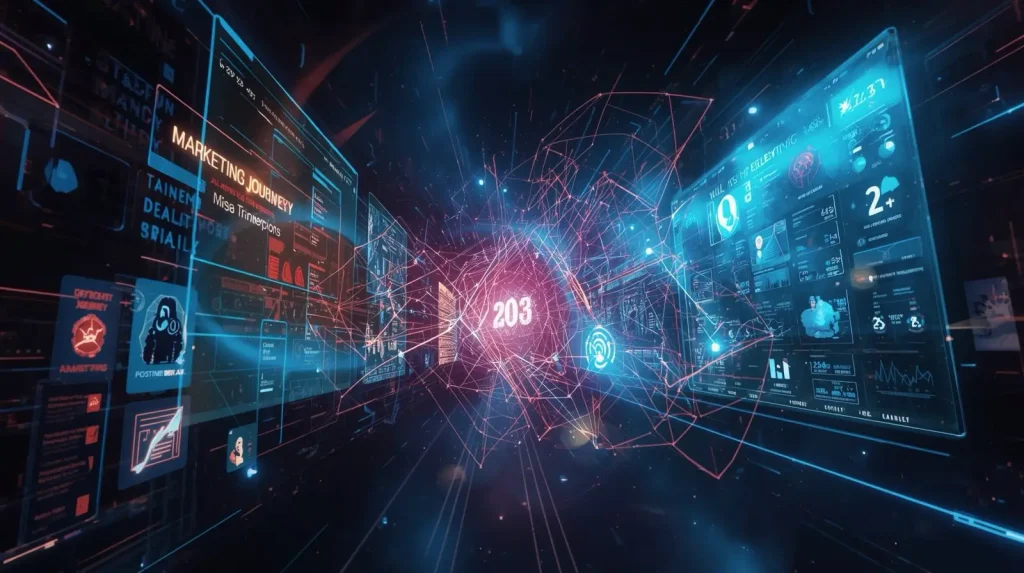
|
Getting your Trinity Audio player ready...
|
The explosion of ChatGPT in late 2022 was a watershed moment. For marketers, it was a glimpse into a future of automated content creation, instant copywriting, and conversational customer service. It was revolutionary, but in hindsight, it was merely the opening act. As we stand firmly in 2025, the conversation has shifted dramatically. We’ve moved beyond viewing AI as a collection of clever tools and begun to recognize it as the central nervous system of modern marketing.
The initial wave was about task automation; the current one is about strategic transformation. AI is no longer just an assistant that writes blog posts or designs ad variants. It has become a foundational pillar, an intelligent ecosystem that underpins every facet of marketing, from deep consumer insight to predictive orchestration of the customer journey. The defining marketing trends of today are not just influenced by technology—they are born from it. For leaders, the question is no longer if they should adopt AI, but how deeply they can integrate an AI strategy into the very fabric of their business to survive and thrive.
The 2025 Marketing Landscape: Ecosystems Over Engines
Two years ago, the market was flooded with standalone “AI-powered” solutions. Today, the landscape has matured into interconnected ecosystems. The most significant evolution in AI marketing 2025 is the move from isolated generative or analytical tools to holistic platforms that merge data, prediction, and creation.
The current environment is characterized by three core realities:
- Hyper-Personalization at Scale: The dream of a one-to-one conversation with millions of customers is now a practical reality. AI platforms can now analyze behavioral data, contextual signals, and historical preferences in real-time to deliver dynamically personalized experiences across all touchpoints. This goes far beyond inserting a customer’s name into an email. We’re talking about websites that reconfigure their layout based on a user’s browsing patterns, video ads with generative elements that adapt to demographic data, and product recommendations so prescient they feel like genuine assistance rather than a sales pitch.
- The Privacy Paradox and Zero-Party Data: With the deprecation of third-party cookies and rising consumer demand for data privacy, marketers faced a potential crisis. AI has turned this challenge into an opportunity. By offering genuine value—through personalized quizzes, interactive tools, and preference centers—brands are encouraging customers to volunteer their data. AI-driven systems then use this “zero-party” data to build sophisticated, consent-based profiles, ensuring compliance while delivering the deep personalization that modern consumers expect.
- Intelligent Automation 2.0: Early automation was rules-based. If a user abandons their cart, then send an email. Today’s intelligent automation is predictive and adaptive. AI can now forecast the likelihood of churn and proactively trigger a retention campaign, identify the optimal channel and time to deliver a message for maximum impact, and even manage complex, multi-channel advertising budgets, reallocating funds in real-time to the highest-performing segments.
This landscape is powered by a confluence of technologies—not just Large Language Models (LLMs), but also diffusion models for image generation, predictive analytics engines, and reinforcement learning algorithms that continuously optimize campaign performance.

AI Strategy Becomes Business Strategy
One of the most profound shifts of the past year is the elevation of the marketing department. Armed with powerful predictive insights, Chief Marketing Officers are no longer just guardians of the brand; they are strategic advisors in the boardroom. An effective AI strategy in marketing has become inseparable from the overarching business strategy.
When an AI system can accurately forecast a dip in demand for a specific product line in a certain region, that’s not just a marketing insight—it’s a supply chain, finance, and product development signal. Marketing has evolved into the company’s primary data-driven intelligence hub. This alignment is creating a powerful feedback loop:
- Predictive Insights Drive Decisions: Marketing teams are now providing leadership with forward-looking models on market expansion opportunities, competitive threats, and shifts in consumer sentiment, all backed by robust AI analysis.
- Resource Allocation Becomes Scientific: Instead of relying on historical data and gut feelings, budget allocation for product launches, campaigns, and market entries is now guided by AI-powered forecasts that predict ROI with a startling degree of accuracy.
- Product Development is Customer-Led: AI analysis of social media conversations, product reviews, and customer service interactions provides a real-time, unfiltered view of what customers want. This qualitative data, processed at scale, is directly informing the next generation of products and services.
In 2025, a company without an integrated AI marketing 2025 plan is operating with a blindfold on. Its competitors, meanwhile, are using AI to see the future.
The Rise of Predictive and Generative Synergy
The true magic of modern AI marketing lies in the synergy between predictive and generative models. These two branches of AI, once largely separate, now work in a harmonious, powerful partnership. Predictive AI acts as the “brain,” while generative AI serves as the “voice.”
- Predictive AI sifts through mountains of data to identify patterns, forecast outcomes, and recommend actions. It answers the questions: Who should we talk to? What are they likely to buy next? When is the best time to engage them?
- Generative AI takes those instructions and crafts the actual message. It creates the ad copy, the email subject line, the social media image, or the personalized video that will resonate most deeply with the identified audience segment.
Consider a hypothetical example of a global travel brand in 2025:
- Prediction: The company’s AI analytics platform identifies a micro-trend: a growing interest in sustainable, off-the-beaten-path travel among young professionals in Northern Europe. It also predicts that this cohort is most responsive to short-form video content on emerging social platforms between 7 PM and 9 PM on weekdays.
- Generation: Armed with this insight, the generative AI engine instantly gets to work. It creates dozens of video ad variations, each featuring stunning, AI-generated visuals of serene, eco-friendly destinations. The copy is tailored to resonate with values of sustainability and adventure, and the voiceover is generated in a warm, authentic tone.
- Orchestration & Optimization: The AI-driven campaign manager deploys these ads across the identified channels at the optimal times. As performance data flows in, a reinforcement learning model analyzes which visuals, copy variations, and calls-to-action are performing best. It then instructs the generative engine to create new, optimized variations in real-time, ensuring the campaign becomes progressively more effective with every passing hour.
This closed-loop system of prediction, creation, and optimization is the new engine of marketing growth. It’s adaptive, incredibly fast, and operates at a scale and complexity that is impossible to manage manually.
Ethical and Creative Frontiers: Navigating the New Terrain
With great power comes great responsibility. The rapid advancement of AI in marketing has brought critical ethical and creative questions to the forefront. Leaders in AI marketing 2025 are not just technologists; they are ethicists and creative directors, tasked with steering this powerful ship with a strong moral and brand compass.
Key considerations include:
- Authenticity and Trust: Can a brand message generated by an AI be truly authentic? The consensus is that authenticity comes from the brand’s values, not the tool used to communicate them. The best practice is to use AI as a collaborator—a “creative co-pilot”—with human oversight ensuring that every piece of content is aligned with the brand’s voice and purpose. Transparency is also key; some forward-thinking brands are even experimenting with “AI-assisted” content labels to build trust.
- Bias in the Algorithm: AI models are trained on vast datasets, and if that data contains historical biases, the AI will perpetuate and even amplify them. Responsible organizations are now investing heavily in data hygiene, bias detection algorithms, and diverse human oversight teams to audit their AI systems regularly. The goal is to ensure that personalization doesn’t lead to digital redlining or the reinforcement of harmful stereotypes.
- The Future of the Marketer: Fears that AI would replace human marketers have proven to be unfounded. Instead, AI has elevated the role. The most valuable marketing professionals today are not the ones who can write the cleverest copy or design the prettiest ad. They are the strategists, the creatives, and the empathizers who can ask the right questions, interpret the AI’s output, and infuse the technology-driven strategy with human insight, creativity, and intuition.

Preparing for the Next Leap: Skills, Metrics, and Mindset
To lead in this new era, marketers must evolve. The skills and metrics that defined success five years ago are rapidly becoming obsolete. The leaders who will shape the future of marketing trends are focusing on three areas:
1. Skill Shifts:
- From Channel Managers to Journey Orchestrators: Focus less on mastering a single platform (e.g., “social media expert”) and more on understanding how to design and manage seamless, data-driven customer journeys across all touchpoints.
- From Content Creators to Prompt Engineers & Creative Directors: The ability to craft precise, insightful prompts for generative AI is now a highly valued skill. This requires a deep understanding of both the brand’s strategic goals and the AI’s capabilities.
- From Data Analysts to Insight Interpreters: With AI handling the heavy lifting of data processing, the human role is to interpret the strategic implications of that data and translate it into actionable business initiatives.
2. New Metrics for a New Era:
- Predictive KPIs: Move beyond backward-looking metrics like cost-per-acquisition. The new gold standards are predictive metrics like Customer Lifetime Value (pCLV), predicted churn rate, and likelihood to convert.
- Personalization Effectiveness: Measure the uplift generated by personalization efforts. How much more valuable is a customer who receives a dynamically personalized experience versus one who doesn’t?
- Speed to Insight: How quickly can your team move from raw data to a strategic, AI-informed decision? In today’s market, speed is a critical competitive advantage.
3. The Mindset for Innovation:
- Embrace Perpetual Beta: The tools and technologies are evolving at an exponential rate. Cultivate a team culture of continuous learning, experimentation, and adaptation. What works today might be obsolete in six months.
- Foster Human-Machine Collaboration: View AI not as a threat, but as a powerful partner. Encourage your team to experiment with AI tools, learn their strengths and weaknesses, and discover new ways to blend machine intelligence with human creativity.
Conclusion: The Human Future of AI Marketing
As we look toward the horizon, it’s clear that the future of marketing is not a dystopian world run by algorithms. Rather, it is one where technology handles the scale, the speed, and the complexity, freeing up human marketers to do what they do best: to understand human needs, to build genuine relationships, to tell compelling stories, and to create brands that people truly love.
The AI revolution in marketing is not about replacing the artist with a machine. It’s about giving the artist a smarter brush, a wider canvas, and the ability to paint in colors they never imagined. The most successful brands of the next decade will be those that master this new art of collaboration, blending the analytical power of artificial intelligence with the irreplaceable spark of human intuition and creativity.
What is your organization’s AI strategy for the coming year? Share your thoughts and experiences in the comments below—let’s learn from each other as we build the future of marketing.
